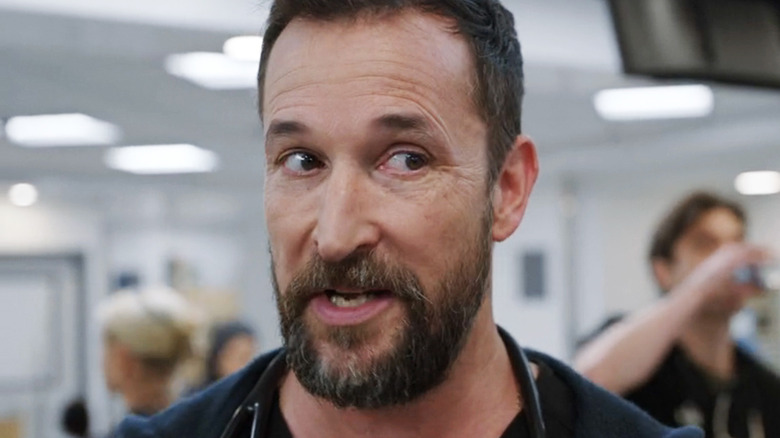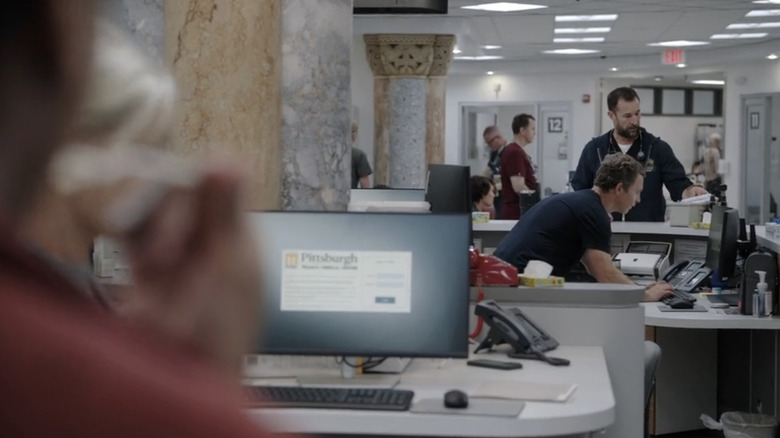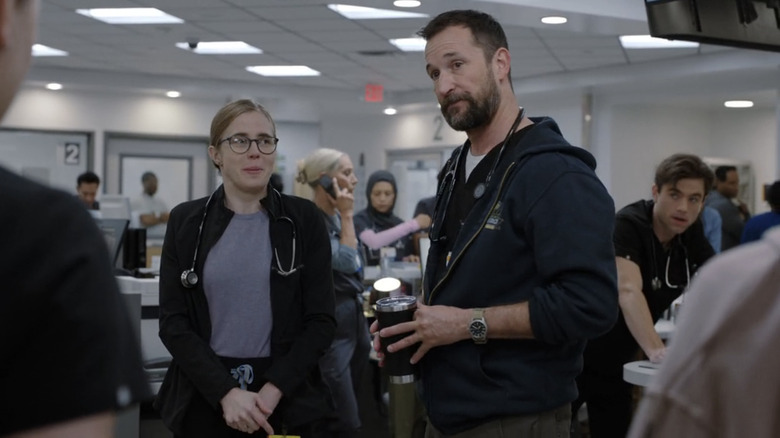The Pitt's Emergency Room Set Had A Surprisingly High Cost
It's funny to think that, with how many medical dramas exist, all anyone had to do to stand out was to just show audiences what being a doctor is actually like. HBO Max's hit series "The Pitt" has been praised as one of the most accurate medical dramas ever made, with the show proving to be a huge success among general audiences and real doctors alike. The secret, it seems, was to make the show as realistic as possible. Not only does "The Pitt" make a point of not using music at all, but the cast of "The Pitt" is mostly up-and-coming actors without much of a public profile. A naturalistic, handheld filming style heightens the sense of realism, as does the production design, which is so good you might well be convinced the series was shot in a real hospital.
It would make sense, after all. If you were going to make the most realistic medical drama ever made, you might consider tracking down some unused medical space and tailoring it to your needs. Instead, the ER depicted in "The Pitt" is actually built on sound stages at Warner Bros. studios in Burbank, California. But that set is built with such attention to detail that it might as well be a real place.
The fictional Pittsburgh Trauma Medical Center, where Dr. Michael Robinavitch (Noah Wyle) and his team of emergency medicine practitioners work is as immersive a place as any ever depicted on-screen. Most of that is down to production designer Nina Ruscio, who based her designs on the real Allegheny General Hospital in Pittsburgh. Creating such a realistic set, however, did not come cheap.
The Pitt created a very realistic and very expensive emergency room set
Before "The Pitt" debuted, there was no indication that it would be the sensation it has since become. Just before the show's debut, Noah Wyle, who previously starred in the seminal medical drama "ER," had been leading an epic made-for-TV fantasy franchise in the form of the TNT TV movie "The Librarian: Quest for the Spear," and his "ER" days were far behind him. But after joining forces with fellow "ER" alums R. Scott Gemmill and John Wells, Wyle found he had a story well worth telling about doctors and their modern-day experiences. That is to say that he was eager to convey just how much trauma emergency doctors endure in a real workplace, especially in the wake of the global pandemic. As the actor told Stephen Colbert, "The three of us [Wyle, Wells, and Gemmill] came back together only because during Covid we recognized that there was another story to tell, and that it was important to us to tell it. This is a community we care a lot about."
The trio went into "The Pitt" with verisimilitude in mind. While they were making an HBO Max drama, this was essentially a real story they were telling about real doctors. As such, acting out their visceral medical drama on a set that didn't exemplify that commitment to realism was never an option. This is where Nina Ruscio came in. The production designer created what was an entirely believable medical set on the Warner Bros. lot, complete with a marble-clad, claustrophobic waiting room and a realistically sterile, lived-in ER. Ruscio took major cues from Pittsburgh's Allegheny General Hospital, in particular emulating the marble columns from the real-life hospital in her Burbank-based version. "The Pitt" was filmed almost entirely on this set (with a few shots captured at the real Pittsburgh hospital).
Creating such an immersive and expansive set, which spanned two sound stages at Warner Bros., wasn't exactly the cheapest project. According to the Wall Street Journal, the creation of the faux-ER cost $4 million and was one of the most expensive items on "The Pitt."
The expensive Pitt set actually kept overall costs low
Talking about the creation of "The Pitt" set with Variety, Nina Ruscio explained the central principles behind the design. "The intentionality of this was to create a level of realism that would make it almost more documentary than narrative," she said. "It's an extremely blanched palette." She and the crew certainly managed to pull off the realism aspect, but building everything from scratch clearly came with a price tag.
That said, it seems building their own set allowed the show runners to actually save in the long term. Executive producer John Wells previously revealed that "The Pitt" costs about $4 to $5 million per episode and that the team was able to keep costs low thanks to the set itself, which meant they didn't have to spend an inordinate amount of their budget on expensive CGI. As such, "The Pitt" is actually a relatively inexpensive series as far as streaming series go. "Severance," for example, cost $20 million an episode in its second season, and Netflix reportedly spent $30 million an episode on "Stranger Things" season 4.
As expensive as "The Pitt" set was, then, it was also one of the main reasons why the creative team stayed within budget. With "The Pitt" season 2 officially greenlit, it will be interesting to see how much HBO Max invests in the series going forward,d now that it has proven itself to be one of the most exciting and popular new shows of the year.


